

Clamping Down on Mercury Emissions
Lab’s Computation Science Expertise Recognized Under SciDAC-2 Program
Clamping Down on Mercury Emissions
Someday, those mercury warning labels posted near the fish section of supermarkets may join lead paint and asbestos as relics of a bygone era.
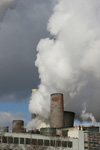
Berkeley Lab scientists led by Shih-Ger (Ted) Chang have developed a potentially cheap and efficient way of removing mercury from coal-fired power plant emissions. The technique, which joins a portfolio of methods the Department of Energy is pursuing to cut mercury emissions from power plants, could help prevent the toxic element from entering the environment and a food chain that culminates at the dinner table. It could also help electric utilities meet a new Environmental Protection Agency rule aimed at curbing power plant mercury emissions.
Although Chang’s mercury-slashing technique is still under development — it was recently licensed to an East Bay engineering firm called Mobotec USA where it will undergo pilot-scale testing — early lab-based experiments indicate that it possesses the hallmarks of a successful pollution control technology.
“It promises to be effective, the capital investment would be small, and it is a relatively simple technology to implement,” says Chang, an Environmental Energy Technologies Division scientist who developed the method over the last five years, funded by DOE’s National Energy Technology Laboratory.
As envisioned, his technique involves injecting a specially formulated gas into the mercury-laden flue gas of a coal-fired power plant, where it can convert elemental mercury into oxidized mercury, a form more easily captured by existing pollution control devices.
Chang’s technique is just one piece to a very large puzzle. Mercury is found throughout the natural world, including coal and many other rocks. Ridding the environment of human-made mercury pollution will require several pollution-reduction strategies aimed at a range of industries, not just electric utilities. And Chang’s technique won’t eradicate mercury emissions from all power plants. Today’s plants burn several types of coal and use myriad kinds of boilers, thwarting a one-size-fits-all approach to pollution control. But it could make a large dent in the 48 tons of mercury emitted by U.S. coal-fired power plants each year, which is the largest human source in the U.S., comprising one-third of all domestic mercury emissions. The problem is also global. China’s booming coal combustion industry emits more than 200 tons of mercury per year into the atmosphere, some of which drifts to the U.S.
Over time, some of the mercury released into the environment by power plants changes to methylmercury, which is a potent neurotoxin that is known to be detrimental to developing fetuses and young children. It is passed from prey to predator along the food chain, building up in certain types of fish and shellfish that people love to eat. In fact, methylmercury can accumulate in fish and marine mammals in concentrations hundreds of thousands times higher than the levels in surrounding waters, which is why state environmental regulatory agencies often issue fish consumption advisories.
Last year, the Environmental Protection Agency attacked the problem at its source by issuing a rule that requires an overall reduction in coal-fired power plant mercury emissions of about 70 percent by 2018.
“Although conventional controls can capture some mercury, new controls will be needed to meet the new EPA standard,” says Chang.
The push to further ratchet down mercury emissions is made difficult because the element courses through a power plant’s smokestack, or flue gas, in three forms: elemental mercury in gas form, and oxidized mercury in either particle or gas form. The latter two oxidized forms can be harvested from flue gas using existing air pollution control devices, such as particulate collectors and sulfur dioxide scrubbers. That leaves elemental mercury, which is highly volatile and insoluble in water and therefore not easily netted by today’s technologies. Making matters worse, once it gets out, elemental mercury persists in the atmosphere for more than one year before it oxidizes, giving it plenty of time to drift around the globe.
Rather than trying to cull the elusive elemental mercury from flue gas, which is a costly and technologically tricky endeavor, Chang decided to try to convert it to a more controllable form.
“Because oxidized mercury can be readily captured by existing methods, a logical approach is to find a cost-effective way of oxidizing elemental mercury,” says Chang.
There are techniques that can already do this, such as treating a commonly used pollution control material, called powdered activated carbon (PAC), with oxidants, and injecting this particulate mix into flue gas. But PAC treated with oxidants costs about $5,000 per pound of mercury captured. That’s cheaper than using untreated PAC, which costs $60,000 per pound of mercury removed, but still too expensive.
Instead of using PAC, Chang turned to specially prepared gasses that have the ability to selectively hunt down and oxidize elemental mercury. Once injected into a power plant’s waste stream, these gasses, either a halogen gas or a halogen-containing gas mixture, largely ignore other pollutants such as sulfur dioxide and nitrogen oxides and react mostly with elemental mercury.
“Its selective ability is very important,” says Chang. “We want the gas oxidant to quickly and mainly react with elemental mercury because it has less than 10 seconds to do its job before the flue gas passes through the air pollution control devices.”
In addition, the gas oxidant adsorbs onto fly ash, which contains some unburned carbon from coal, and forms a particle that can also oxidize elemental mercury. This means that Chang’s technique is doubly efficient: elemental mercury can be oxidized by the gas oxidant as well as on the carbon in the fly ash. It also means that PAC does not have to be used, which is another cost saver. And this, in turn, yields even more savings. Fly ash from flue gas treated with PAC contains too much carbon to be sold to the cement industry, which is a significant source of revenue for power plants. With Chang’s technique, however, the fly ash remains suitable for the cement industry.
“This promises to be effective and much cheaper than many other techniques,” says Chang. “After it’s treated with the gas oxidant, existing control devices used for other pollutants can remove the oxidized mercury from the waste stream.”
Lab’s Computation Science Expertise Recognized Under SciDAC-2 Program
Berkeley Lab’s expertise and leadership in computational science was recognized and rewarded last week when DOE Under Secretary for Science Ray Orbach announced the second round of projects under the Scientific Discovery through Advanced Computing (SciDAC) program, to be funded at $60 million per year.
 Using algorithms developed under SciDAC, Berkeley Lab applied mathematicians worked with combustion scientists in EETD to create this 3D simulation of a laboratory-scale flame consisting of 19 chemical species and 84 fundamental chemical reactions.
Using algorithms developed under SciDAC, Berkeley Lab applied mathematicians worked with combustion scientists in EETD to create this 3D simulation of a laboratory-scale flame consisting of 19 chemical species and 84 fundamental chemical reactions.
The SciDAC program, launched in 2001, brings together some of the nation’s top researchers at national laboratories and universities to create the software and infrastructure needed to help scientists effectively utilize the next generation of supercomputers for tackling the toughest scientific challenges — some of which can only be studied through high performance computation and simulation. A hallmark of the program is collaboration between scientific application teams and groups working to develop software tools for improving the scientific codes.
Of the 30 projects announced, Berkeley Lab researchers will lead five and play key roles in eight others. The Lab’s projects, most of which are five years in length, will be funded at about $10 million annually.
“This is very exciting and very welcome news in that all of the proposals were rigorously reviewed and we were selected to contribute in significant ways to nearly half of the projects,” said Associate Lab Director for Computing Sciences Horst Simon. “What is especially gratifying is that funding at Berkeley Lab has increased compared to SciDAC-1 and our contributions were such that DOE felt the work should continue. When you look at the big picture, it’s clear that Berkeley Lab is one of the foremost institutions for computational science.”
The Applied Partial Differential Equations Center, established under the first round of SciDAC, develops simulation tools for solving multi-scale and multi-physics problems. Their algorithms have been used to create laboratory-scale turbulent flame simulations, study refueling of fusion reactors, and model combustion in supernovae. The center will continue under the leadership of Phil Colella of the Computational Research Division (CRD).
The Scientific Data Management Center will also be continued under SciDAC-2. Led by Arie Shoshani of CRD, the center develops tools to improve the sharing and analysis of massive amounts of data from both simulations and experiments. One of its key accomplishments under the first round of SciDAC was the development of FastBit, an indexing method which enables data searches up to 10 times faster than commercial search tools.
A new center created under SciDAC-2 will be the Visualization and Analytics Center for Enabling Technologies (VACET), led by CRD’s Wes Bethel, which will develop tools to help scientists effectively understand and make use of the growing amounts of data. The VACET center will respond directly to this challenge by adapting, extending, creating when necessary, and deploying technologies that will enable scientific stakeholders to visualize and understand the wealth of data now available to them.
Another new project centered at Berkeley Lab will be the SciDAC Outreach Center, to be led by David Skinner. Located at NERSC, the center will provide information and services that support SciDAC outreach, training, and research objectives. Additionally, the center will gather data to understand the needs of the HPC community to identify workshops, summer schools, institutes and research topics to meet those needs.
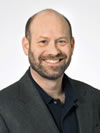
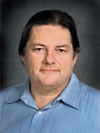
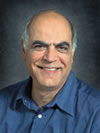
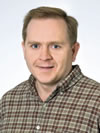
 Left to right, Bethel, Colella, Shoshani, Skinner, and Brenner
Left to right, Bethel, Colella, Shoshani, Skinner, and Brenner
Several new scientific domains, including biology and underground transport, were added to SciDAC as part of the second round. Steven Brenner of Physical Biosciences, along with Michael Jordan of UC Berkeley, are co-leaders of the Robust and Precise Gene Function Predictions on a Genomic Scale project. This project will refine algorithms to automate a process for predicting the functions of proteins in a family of microbes. By better understanding the function of these proteins, DOE hopes to harness the potential of microbial communities for the remediation of contaminated sites, development of smart sensors, and the bio-generation of hydrogen and ethanol.
Berkeley Lab Computing Sciences staff in CRD and the NERSC Divi-sion will also serve as co-investigators in eight other SciDAC projects addressing research issues in astrophysics, sharing and managing massive amounts of scientific data, developing software for next-generation supercomputers, developing new software tools for studying complex problems, and assessing and improving the performance of large-scale computers.
More information about the SciDAC program can be found at www.scidac.gov.
29th ANNUAL Berkeley Lab RUNAROUND
Before You ‘Runaround,’ Make Sure You’re Ready
FRIDAY, OCTOBER 13
START: FIREHOUSE AT NOON SHARP
FINISH: CAFETERIA
DISTANCE: 3 km (1.86 mi)
The 29th annual Berkeley Lab Runaround is three weeks away, slated for Friday, Oct. 13 at noon. Whether you’re jogging the hills for the first time, or a seasoned runner hoping to move up in the standings, here are a few tips culled from the experts that will help you avoid those aching muscles and disappointing results.
First, says Lab Health Care Facil-itator Loida Bartolome-Mingao, potential runners should assess their limits before they race. “If you’ve been inactive and plan to take on the Runaround course for the first time, talk to your doctor beforehand to learn about any precautions you might need to take.”
Unless you’ve been doing a cardiovascular sport, running experts suggest the best way to prepare is to start training with a walk/run program. Try alternating two minutes walking with one or two minutes jogging; go for 10-20 minutes the first time, then build it up over a period of weeks, gradually increasing the total time and the proportion of running. It’s always a good idea to test out the course ahead of time (see route map above) to get a feel for the terrain.
Make it a habit to warm up before every walk or run, which decreases the likelihood of injuring muscles. Begin by walking or jogging slowly to limber up, then do a few stretches before you head to the starting line.
No matter how experienced you are, if there is pain during or after a workout, take a few days rest before returning to your regimen, or more if necessary. Injuries are most commonly caused by going too far or too fast too soon. When in doubt, rest. Don’t let a niggling pain become a full-blown injury.
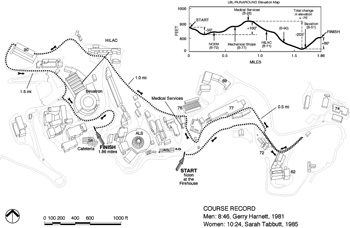
On the day of the race, Bartolome-Mingao suggests wearing polyester or polyester-blend socks with reinforced heels and toes to prevent blisters and to keep your feet dry. Also be sure there are no creases in your socks across the bottom of your feet. Wear a good pair of running shoes that have already been broken in. These should fit snugly to reduce the slipping and sliding that can lead to blisters.
Lastly, don’t forget to drink enough fluids. Try to drink about two glasses of fluid in the two hours before the race, then as needed during and after the race. And as with any activity that takes place outdoors during the day, slather on the sunscreen.
Bartolome-Mingao says, whether you race alone or team up with friends, enjoy yourself. As with all exercise, having a good experience means you are more likely to stick with a healthy regimen and be ready to tackle the 30th Runaround next year.
Snapshot: An inside look at one of the Lab’s many interesting employees…
Job:
Staff Research Associate, Indoor Environment Department
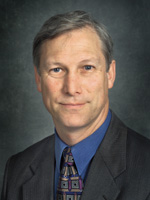 David Faulkner
David Faulkner
Childhood Ambition:
Engineer
Weirdest job:
Flipping burgers as a teenager
Guilty Pleasure:
Ice cream
Hero:
Richard Feynman
Proudest Moment:
My daughter’s duet winning a National Synchronized Swimming Championship and my son’s selection to the All-Star Hockey Team
Last Book Read:
Breaking the Ice: The Black Experience in Professional Hockey
Current Tunes on iPod or CD Player:
Jean-Luc Ponty
Favorite Movie(s):
Koyaanisqatski
When Not Working:
Shuttling children to practices
Ideal Vacation:
Europe
Berkeley Lab View
Published once a month by the Communications Department for the employees and retirees of Berkeley Lab.
Reid Edwards, Public Affairs Department head
Ron Kolb, Communications Department head
EDITOR
Pamela Patterson, 486-4045, [email protected]
Associate editor
Lyn Hunter, 486-4698, [email protected]
STAFF WRITERS
Dan Krotz, 486-4019
Paul Preuss, 486-6249
Lynn Yarris, 486-5375
CONTRIBUTING WRITERS
Jon Bashor, 486-5849
Allan Chen, 486-4210
David Gilbert, (925) 296-5643
DESIGN
Caitlin Youngquist, 486-4020
Creative Services Office
PHOTOGRAPHY
Roy Kaltschmidt, 486-5731
Creative Services Office
Berkeley Lab
Communications Department
MS 65, One Cyclotron Road, Berkeley CA 94720
(510) 486-5771
Fax: (510) 486-6641
Berkeley Lab is managed by the University of California for the U.S. Department of Energy.
Online Version
The full text and photographs of each edition of The View, as well as the Currents archive going back to 1994, are published online on the Berkeley Lab website under “Publications” in the A-Z Index. The site allows users to do searches of past articles.
Flea Market is now online at www.lbl.gov/fleamarket
Berkeley Lab at 75: A New Chapter of Achievement
What was it, Nobel Laureate Steven Chu was asked by a reporter, that got him to leave the relatively cozy world of research at Stanford University to face the bureaucratic rigors of management as director of Lawrence Berkeley National Laboratory?
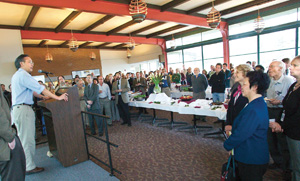 Director Chu addresses Lab employees in the cafeteria after the Department of Energy announced that the University of California will continue its management of the Lab.
Director Chu addresses Lab employees in the cafeteria after the Department of Energy announced that the University of California will continue its management of the Lab.
“I had roughly a third of my career left,” he told the reporter. “I thought, ‘Should I be doing other things?’ I was feeling a greater pull toward the energy problem and what could be done about it. I was also concerned that UC Berkeley’s physics department was in danger of slipping, and that it needed to stay in the leagues of the Harvards and the Stanfords.”
In the end, he said, he decided to “step into the cauldron,” and in August of 2004, he took the reins of what he described as a “national treasure,” a research environment that over its eight decades had built an impressive legacy of seminal contributions to science. At its heart was Ernest Lawrence’s collaborative approach to science, and Chu vowed to make this culture of interdisciplinary problem-solving even better.
The problem of energy supply, and of finding and developing carbon-neutral, self-sustaining, environmentally benign sources of power, Chu labeled “the single most important societal problem that science and technology must face.” And he pledged to marshal Berkeley Lab’s strengths in biological, chemical and computational sciences, its world-class facilities, its distinguished corps of engineers, and its pioneering initiatives in nanotechnology and synthetic biology to lead this country’s efforts at maintaining its competitive edge while mitigating the effects of global warming.
When he walked through the door, however, Chu discovered an immediate and significant threat to his plans. For the first time in its history, the Laboratory faced possible separation from its manager and guide, the University of California. Under new procedures established by the federal Department of Energy, science labs like Berkeley’s would now have to compete their management contracts among all bidders.
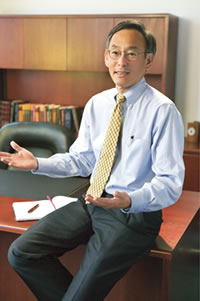 Berkeley Lab Director Steve Chu.
Berkeley Lab Director Steve Chu.
Potentially without UC at the helm, Chu knew his tenure at Berkeley Lab might be brief indeed.
So he assembled a mighty team of Lab senior managers and staff, working with UC advisers from the President’s Office, to build the case for continued UC management. What resulted in spring 2005 was the DOE’s unanimous decision to maintain the relationship, convinced as they were that the leadership of Nobel Prize-winning physicist Chu, plus the Lab’s extraordinary resources and strong partnerships with UC Berkeley, UC San Francisco and other institutions, promised exciting opportunities ahead.
Such promises were given a boost on March 24, 2006, when the 94,500-square-foot Molecular Foundry was dedicated and then began operations as the most advanced nanoscience research facility in the nation. Focusing on fabrication strategies for both inorganic and organic materials, the new facility — one of five funded by the Department of Energy’s Office of Science — was poised to deliver such tantalizing prospects as electronic devices made out of carbon nanotubes, compounds to detect and treat disease at the cellular level, and sensors for real-time monitoring of chemical and biological activity.
Next-generation solar cells were also on the Foundry’s to-do list, which would fit nicely into Chu’s visionary energy program called “Helios.” That was his umbrella term for Berkeley Lab’s quest to develop abundant and inexpensive solar-based energy technologies. As Chu’s term as Director entered its third year, he was busy securing valuable alliances with academia and industry, poised to compete for financial support to carry out his ambitious initiative. As more and more experts, including those at Berkeley Lab, cited evidence of a global warming trend that could lead by century’s end to water and energy shortages and even deaths, Berkeley Lab rallied its expertise for the challenge.
The Director had another priority that dominated his first years in office — safety, and the need to improve it. “We have to change the culture here to incorporate safety into everything we do,” he told an all-hands meeting in early 2005. Despite the Lab’s solid record of safe performance, the Office of Science demanded better, with a standard to which most industrial labs are not held. This “zero tolerance” message, punctuated by safety reviews and training, reverberated through laboratories and offices alike.
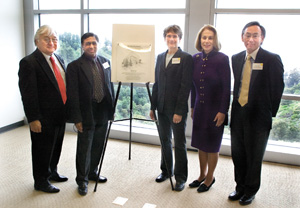
The Molecular Foundry dedication included (from l-r) U.S. Representative Mike Honda, Altaf Carim, with the Office of Science, Foundry Director Carolyn Bertozzi, State Secretary of Business, Transportation and Housing Sunne McPeak, and Director Chu.
Berkeley Lab’s scientific progress would be dependent upon new ideas and contemporary buildings. Chu presaged what he had in mind when, on his first anniversary at the Lab, he said, “We would like to construct a hostel for the Lab’s scientific visitors, an energy/nanotechnology building, a computational sciences center, and an ALS user support building…We continue to push for the Joint Dark Energy Mission (JDEM) and our proposal for this mission, the SuperNova Acceleration Probe (SNAP).”
As if to prove the point, Saul Perlmutter, astrophysicist and SNAP Godfather, received two international prizes in 2006 for his efforts in identifying and measuring the expansion of the universe.
Chu continued, “Our Lab initiatives also include continuing efforts in quantitative biology, including exciting collaborations with researchers at UC San Francisco (with National Cancer Institute support); in health diagnostics, genomic analysis and application. Our physical scientists continue to probe the origins of matter and energy by developing and utilizing tools that can study the infinitesimally small — both particles and processes. The Advanced Light Source, a model user facility by any measure, will reinvent itself to remain effective and useful for many years to come, and the Joint Genome Institute is poised to become the international center for microbial sequencing.”
 The cover of the Helios Project brochure.
The cover of the Helios Project brochure.
Synthetic Biology, distinguished at Berkeley Lab by being the first department of its kind in the country, took on added importance when in March 2005 it moved into spacious, high-tech quarters in a biosciences building in west Berkeley. Jay Keasling, its leader, received a $42.6 million grant from the Bill & Melinda Gates Foundation to develop an affordable, accessible cure for malaria, one of the world’s most intractable diseases. Multidisciplinary efforts in cell and molecular biology, cancer research, and quantitative biology were also housed there.
With apologies to Yogi Berra, Chu has quoted the malaprop king on many occasions, saying, “Making predictions is very difficult, especially about the future.” But his forecast for Berkeley Lab, on the eve of its 76th year, was confident:
“My vision for the future of Berkeley Lab when I arrived, and remains now, is to be a model facility for connectivity across divisions, a creative and nurturing environment that develops and grows new initiatives and the talented people who make them happen.”
This is the last installment of the view’s historical series on Berkeley Lab.
Founders Day, Aug. 26, 2006: It Was a Special Time For...
… tributes.
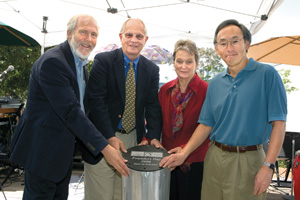 From left, Berkeley City Council Member Gordon Wozniak, Berkeley Mayor Tom Bates, State Assemblywoman Loni Hancock, and Lab Director Steve Chu, display the time capsule, full of items that will give those who open it in 2031 a glimpse of life at the Lab in 2006.
From left, Berkeley City Council Member Gordon Wozniak, Berkeley Mayor Tom Bates, State Assemblywoman Loni Hancock, and Lab Director Steve Chu, display the time capsule, full of items that will give those who open it in 2031 a glimpse of life at the Lab in 2006.
On the sun-dappled stage beneath the trees outside the Berkeley Lab cafeteria, Laboratory Director Steve Chu saluted the vision and inspiration of Ernest Lawrence, whose namesake facility took root with a University authorization 75-years-to-the-day earlier.
Berkeley Mayor Tom Bates, wielding his “incredible power to declare a day,” designated Aug. 26 Lawrence Berkeley National Lab Day in the city (“If you mention Berkeley Lab in any coffee shop today, you will be able to buy a latte for $3.50,” he laughed). He also marveled at, and honored, “this amazing place.”
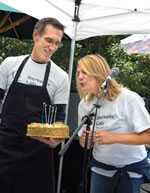 Cafeteria manager Peter Oshinski, left, and event organizer Lyn Hunter (Public Affairs) led visitors in singing “Happy Birthday,” then blew out candles on a cake.
Cafeteria manager Peter Oshinski, left, and event organizer Lyn Hunter (Public Affairs) led visitors in singing “Happy Birthday,” then blew out candles on a cake.
State Assemblywoman Loni Hancock was effusive, especially about the Lab’s history of energy efficiency work pioneered by Art Rosenfeld. She called the Lab “an absolutely essential place in the effort to build a sustainable planet.”
Letters from State Senator Don Perata and U.S. Senator Barbara Boxer contained similar praise. An entry in the Congressional Record, made by Congresswoman Barbara Lee, cited “one of the world’s premier science and research institutions” and congratulated Lab employees past and present “for their ongoing dedication to scientific excellence, and for their distinguished service to our community.”
… reunions.
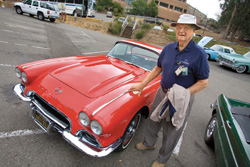 A Lab retiree checks out one of several vintage vehicles at the Founders Day car show.
A Lab retiree checks out one of several vintage vehicles at the Founders Day car show.
Among the more than 1,000 celebrants at the all-day family picnic were numerous former Lab employees who spotted old friends, lingered over the historic artifact exhibit, and took site tours to places old and new. Retirees Gerson and Judith Goldhaber won the trivia contest (they even knew the article of clothing from Ed McMillan’s wardrobe that later Nobelists wore to their prize ceremonies — a vest).
… kids.
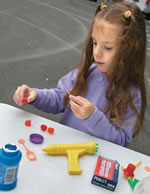 Anamaria Garcia learns about bubbles at one of the Center for Science and Engineering Education�s hands-on experiment tables.
Anamaria Garcia learns about bubbles at one of the Center for Science and Engineering Education�s hands-on experiment tables.
If they weren’t bouncing inside the inflatable trampolines, they were climbing on Alameda County fire engines, rushing to find clues to the pirate treasure hunt, listening to special guest Ivan Schuller talk about the nano world, or learning about bubbles and magnets from the Lab’s science education volunteers. Or eating — over 600 slices of birthday cake, donated by the cafeteria caterers, were gone within an hour.
… predictions.
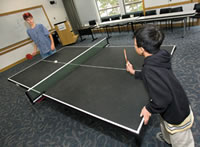 These young men try their hand at ping pong in Perseverance Hall, courtesy of the Lab�s Table Tennis club.
These young men try their hand at ping pong in Perseverance Hall, courtesy of the Lab�s Table Tennis club.
What will Berkeley Lab be like at age 100? Among the many suggestions placed within the time capsule were these: “Bio-fuels based on lingo-cellulose material, including bio-waste, will have displaced about 25 percent of oil we use to produce gasoline” (Steve Chu); “The deep understanding of quantum mechanics and gravity (will lead) us to manipulate the fabric of space and time in such a way that travel across the galaxy becomes feasible” (Jim Siegrist); “Inertial fusion energy will become a reality…offering for the first time a viable alternative to fission” (Steve Gourlay); “We will have technologies that enable us to drive computers, and through them machines, with our thoughts” (Carolyn Bertozzi); “The world will have lost at least one nation amongst the island nations (due to global warming) and that millions of people will be displaced from coastal lands by sea level rise” (Margaret Torn); “We will walk more than we did in 2006” (Tim Xu); “Electronic circuitry, computers and cell phones might be routinely implanted and directly connected to the brain” (Thomas and Ilka Pfeifer); “The Lab will have its first woman Lab director” (Janis Dairiki).
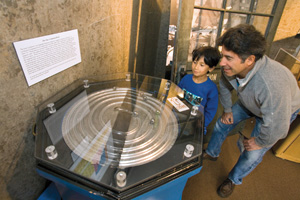 At the historical exhibit in the Building 50 lobby, two visitors watch a cyclotron demonstration.
At the historical exhibit in the Building 50 lobby, two visitors watch a cyclotron demonstration.
… Berkeley Lab.
Anniversaries serve as a reminder of where we’ve been and where we still need to go. They celebrate endurance, relevance, achievement and growth. Thus did Founders Day 2006 honor a memorable legacy, one that will continue for decades to come.
—Ron Kolb

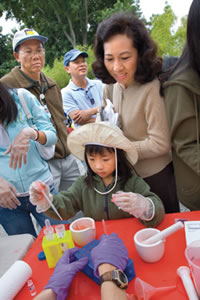
 (Left): Visitors lined up to receive giveaways and sign up for tours of the ALS, Foundry, and the 88” Cyclotron; (Center): This youngster extracted strawberry DNA at the Joint Genome Institute booth; (Right):This little one had a jumping good time in one of two bounce houses stationed in the Building 50 parking lot Kid’s Zone
(Left): Visitors lined up to receive giveaways and sign up for tours of the ALS, Foundry, and the 88” Cyclotron; (Center): This youngster extracted strawberry DNA at the Joint Genome Institute booth; (Right):This little one had a jumping good time in one of two bounce houses stationed in the Building 50 parking lot Kid’s Zone
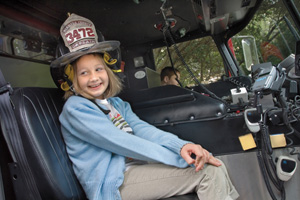
 (Left):A highlight for many children visiting the Kid�s Zone was clambering up into the front seat of a fire engine and donning an official helmet; (Right): Scottish country dancers enchant audience members with their moves on the cafeteria lawn
(Left):A highlight for many children visiting the Kid�s Zone was clambering up into the front seat of a fire engine and donning an official helmet; (Right): Scottish country dancers enchant audience members with their moves on the cafeteria lawn
Berkeley Lab Science Roundup
 A 100-year worst-case simulation shows a 27-foot surge inundating Biloxi, Mississippi (red). New Orleans is the dark blue crescent (indicating surge heights from 0 to 9 feet) to the lower left of Biloxi.
A 100-year worst-case simulation shows a 27-foot surge inundating Biloxi, Mississippi (red). New Orleans is the dark blue crescent (indicating surge heights from 0 to 9 feet) to the lower left of Biloxi.
An urgent practical application of computing power is the effort to understand how hurricane-caused storm surges are liable to impact communities along the changing coastline of the Gulf of Mexico, with particular emphasis on five Louisiana parishes surrounding New Orleans. Two allocations totaling 800,000 processor hours of supercomputing time at the National Energy Research Scientific Computing Center (NERSC) have been made by the Office of Science to the Army Corps of Engineers, working in cooperation with the Federal Emergency Management Agency. Simulations of storm-surge elevations — worst-case scenarios based on 100 years of hurricane data — are being used to design levee repairs and improvements in the wake of Hurricane Katrina.
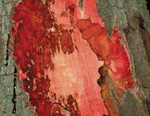 A Phytophthora ramorum infection invades the trunk of a tan oak tree. The microorganism feeds first on live tissue, then consumes dead tissue. (Garbelotto Forest Pathology Lab, UC Berkeley).
A Phytophthora ramorum infection invades the trunk of a tan oak tree. The microorganism feeds first on live tissue, then consumes dead tissue. (Garbelotto Forest Pathology Lab, UC Berkeley).
Evolution of an Environmental Enemy
Sudden Oak Death is caused by a species of a fungus-like water mold, Phytophthora ramorum, which kills oak trees and damages many other plants and shrubs. Other species of Phytophthora attack a wide variety of agricultural crops and wild plants; P. sojae, for example, is responsible for soybean root rot. Now researchers at DOE’s Joint Genome Institute and the Virginia Bioinformatics Institute have compared the complete genomes of these two deadly species and learned many of their disease mechanisms, as reported in the September 1 issue of Science. Understanding how organisms attack their hosts using a disease strategy with several distinct stages allows targeting cellular processes for novel detection systems and effective defenses. Says JGI’s director, Eddy Rubin, “We are now capable of rapidly responding to the urgent needs of the nation’s largest industry: agriculture.”
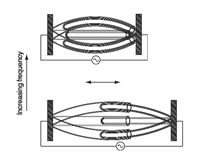 A multiwalled nanotube is suspended between a stationary contact and a piezo-controlled moving electrode. Varying the length of the nanotube beam through the controlled telescoping of the inner nanotube core from the outer nanotube shell tunes its resonant frequency.
A multiwalled nanotube is suspended between a stationary contact and a piezo-controlled moving electrode. Varying the length of the nanotube beam through the controlled telescoping of the inner nanotube core from the outer nanotube shell tunes its resonant frequency.
Nanotube Resonators for Supersensitive Detectors
Tunable, resonating carbon nanotubes could be the basis of tiny, supersensitive, self-assembling chemical and biological detectors. The resonators, created by Alex Zettl of the Materials Sciences Division and his colleagues and described in the June 2 issue of Physical Review Letters, can achieve frequencies greater than 1.3 gigahertz (a gigahertz is a billion cycles per second) and can detect masses as small as an attogram, a quintillionth of a gram. Similar sensitivity has been achieved using laser techniques, but Zettl’s resonators don’t need lasers; instead, by clamping multiwalled carbon nanotubes between two electrodes on a silicon substrate only a few hundred nanometers apart, the length of the nested tubes and thus the vibration frequency can be smoothly varied. The device can be used to measure mass, force, position, or frequency with precision.
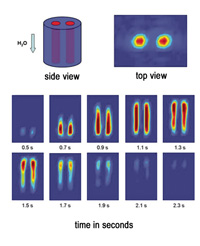 The sensitive new portable MRI system, based on remote sensing and optical atomic magnetometry, was tested using a volume of water passing through two pipes in a cylinder (upper left).
The sensitive new portable MRI system, based on remote sensing and optical atomic magnetometry, was tested using a volume of water passing through two pipes in a cylinder (upper left).
Magnetic Resonance Imaging Makes Its Move
A group of researchers led by Alexander Pines of the Materials Sciences Division and Dmitry Budker of the Nuclear Science Division have developed a new laser-based method of magnetic resonance imaging (MRI) and nuclear magnetic resonance (NMR) that is not only more sensitive but — because it can operate at room temperature — far less expensive and finicky than techniques using comparably sensitive superconducting quantum interference devices (SQUIDs). An extra benefit is that the new NMR/MRI devices are so simple and compact that they can be taken outside the lab and run by battery power. Shoujun Xu, also in the Materials Sciences Division, worked with Pines, Budker, and others on the development of the revolutionary technique, which is described in the August 22 issue of the Proceedings of the National Academy of Sciences.
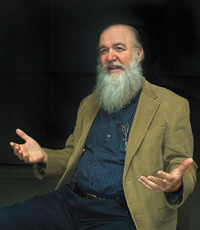 Johnston.
Johnston.
Better Networking for Scientific Discovery
The Department of Energy’s Energy Sciences Network (ESnet), based at Berkeley Lab, is teaming with Internet2, a consortium of universities and industrial partners, to form a new network of unprecedented capacity and reliability that will expand opportunities for scientists involved in DOE research. The existing networks are leaders in the research field. Together they will create a network capable of handling the demands of the Office of Science’s most challenging research projects, including participation in CERN’s Large Hadron Collider and the Relativistic Heavy Ion Collider at Brookhaven. “ESnet and Internet2 share a common technical vision for the evolution of dynamically delivered network capabilities,” says Berkeley Lab’s Bill Johnston, head of ESnet.
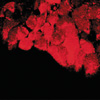 First developed to detect radicals in living cells, as shown here, the hydrogen peroxide detector can by used to test for trace amounts of hydrogen peroxide and other chemicals in liquids.
First developed to detect radicals in living cells, as shown here, the hydrogen peroxide detector can by used to test for trace amounts of hydrogen peroxide and other chemicals in liquids.
Preventing Terrorist Attacks by Detecting Liquid Explosives
In the hands of a terrorist, normally innocent but highly reactive hydrogen peroxide could be a potent ingredient for a bomb. Current airport screening devices can’t detect hydrogen peroxide, but test strips developed by Christopher Chang of the Chemical Sciences Division and his colleagues could light up bright yellow or red if dipped in a liquid containing even trace amounts of hydrogen peroxide. Says Chang, “You don’t need anything to read the selective reaction other than your eye.” Chang’s group originally developed these peroxysensors, which are based on fluorescent dyes, in order to study oxidative stress in living cells, as described in the Nov. 30, 2005 issue of the Journal of the American Chemical Society, but after the bomb plot arrests in England this summer, their potential for increasing airport security became clear.
In Memoriam: Neville Smith, ALS Scientific Director
Neville Smith, scientific director for the Advanced Light Source and a leading authority in the field of photoemission spectroscopy, died at his home in Berkeley of cancer on Aug. 18. He was 64.
A native of England with a Ph.D. in physics from Cambridge University, Smith came to the United States in 1966.
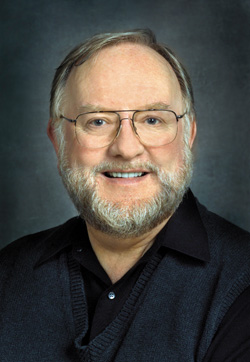 Neville Smith.
Neville Smith.
After doing post-doctoral research at Stanford University, he joined the staff at AT&T Bell Laboratories. There he spent the next 25 years carving a name for himself in the use of x-rays to study the electronic structure of solids and surfaces.
Smith returned to the Bay Area in 1994, when he was named by former Lab director Charles Shank as the first scientific program head of the ALS. Under his leadership, the ALS scientific program thrived.
“It is not the number of warm bodies on the floor but the quality of science produced that is the true measure of a user facility’s success,” Smith once said. During his tenure as scientific director, the number of scientific users of the ALS grew from a few hundred to several thousand.
Smith’s death was unexpected and took his friends and colleagues by surprise.
“The sudden, tragic loss of Neville Smith is a great blow to the ALS and to the entire synchrotron community,” said Director Steve Chu. “He was a distinguished scientist who, in his quiet and unassuming way, played a crucial role in building the quality of the scientific program of the ALS into the stellar program that it is today.”
Patricia Dehmer, who became the Associate Director of Science for DOE’s Office of Basic Energy Sciences, knew Smith as both a colleague and a friend.
“As its scientific director, Neville shepherded the Advanced Light Source to international prominence making it one of the most scientifically productive and important facilities in the world,” Dehmer said. “Moreover, his wisdom, maturity, innovativeness, and diplomacy made him a leader in the national and international light source community. He was a good friend to everyone, particularly those of us in the Department of Energy. We will miss him very much.”
Smith’s ALS colleagues remembered him for his personal warmth as well as for his scientific leadership and expertise.
Said former ALS director Janos Kirz, “Neville was a dear friend over the last 25 years. He was respected and liked by the entire synchrotron radiation community for his solid scientific judgment, and his fine sense of humor. His passing is an enormous loss.”
Ben Feinberg, deputy director of the ALS and another long-time colleague had this to say: “Neville and I worked together closely from the time he first started at the Lab. The ALS and I, personally, will miss him as a friend and confidant, and for his clear, insightful, and playful approach to both scientific and organizational challenges.”
Smith is survived by his wife Elizabeth (Betsy), two daughters, Katherine (Kaci), and Elizabeth (Libby), a daughter-in-law, Arin, and a sister Kathleen France. A memorial service to celebrate Smith’s life will be held later in the fall.
Helen Seaborg, Wife of Famed Nobelist, Dies
Helen Lucille Seaborg, wife of Nobel prize winner Glenn Seaborg and mother of their seven children, died of pneumonia on Aug. 29.
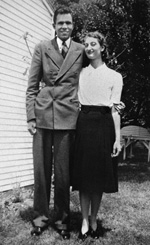
Glenn and Helen Seaborg.
Seaborg began her remarkable life on March 1, 1917, in the Florence Crittenton home for unwed mothers in Sioux City, Iowa, where she was soon adopted by George and Iva Griggs. When her adoptive mother Iva was widowed, she and Helen moved to Southern California; Helen subsequently worked her way through Santa Ana College and UC Berkeley.
After receiving her BA in English in 1939, she went to work for the head of UC’s radiation laboratory, Ernest Lawrence. Her invaluable administrative assistance to Lawrence included introducing master chemist Glenn Seaborg to Albert Ghiorso, who would become Seaborg’s colleague and element-hunting successor.
In June, 1942, Helen and Glenn were on their way to Chicago when they got off the train in Pioche, Nevada, in order to be married by the local Justice of the Peace. The next day they continued to Seaborg’s new assignment at the Manhattan Project’s Metalurgical Laboratory at the University of Chicago.
As wife of the Chancellor of UC Berkeley and the Chairman of the Atomic Energy Commission (Seaborg’s later posts), Helen handled generations of VIPs, including presidents from Kennedy to Reagan, with efficiency and diplomacy. On her own time she was a tireless worker for civil rights and environmental causes. She was especially active in the YWCA.
The family asks that memorial donations may be made to the Berkeley YWCA, 2600 Bancroft Way, Berkeley, CA 94704.
People, Awards, and Honors
BOOMERANG Team Honored For Cosmology
 Borril.
Borril.
The 2006 Balzan Prize for Astronomy and Astrophysics was presented to BOOMERANG, a project developed by a collaboration of scientists, including Julian Borrill of the Computational Research Division. In 1999, BOOMERANG, a balloon-borne experiment flying high above the Antarctic, captured the first resolved images of the Cosmic Microwave Background. The unprecedented combination of angular resolution and sky coverage presented fundamentally new computational challenges in optimal analysis of the maps. Borrill’s group at NERSC helped produce the first dramatic cosmological result in relatively short time: April 2000. A now-famous paper published in Nature reported the first definitive measurement of the geometry of the universe.
Energy Expert Among MIT Review’s Top 35
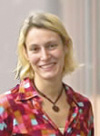 Galitsky.
Galitsky.
Christina Galitsky, a researcher in the Lab’s Environmental Energy Technologies Division, has been named one of 35 top innovators in science and technology under the age of 35 by MIT’s Technology Review magazine. The honoree was also named by the magazine as “Humanitarian of the Year.” Galitsky has worked with EETD scientist Ashok Gadgil on energy-efficient cookstoves for Darfur, and an inexpensive method to remove arsenic from drinking water. She also led the development of the BEST winery tool for improving the energy efficiency of California’s wine industry.
Cancer Expert Awarded Lectureship
 Bissell.
Bissell.
Mina Bissell, Distinguished Scientist in Berkeley Lab’s Life Sciences Division, has been awarded the Ted Couch Lectureship in Cancer Research for 2007. The H. Lee Moffit Cancer Center initiated this award to honor those who’ve made significant contributions to cancer research. The award consists of two lectures, a plaque of recognition, and $10,000. The Moffit Center, located at the University of South Florida, is one of the largest stand-alone cancer hospitals in the country and is a National Cancer Institute Designated Comprehensive Cancer Center.
Champions of Safety: ‘Spot’ Winners Honored
 Bissell.
Bissell.
For their efforts to make Berkeley Lab a safer place, 19 employees received “spot” awards from Director Steve Chu. It was the second set of safety incentive awards given under a new program implemented by Environment, Health and Safety. The winners include Brian Taylor, Vil Anabeza, Janie Morse, Denise Washington, Kevin Haugh, Robert Kelley, James Martinez, Lynn January, Gerald Duncan, and Keith Hayes, all of Facilities; Don Lucas and Robert Cheng of Environmental Energy Technologies; Sharon Buckley Hernandez, Csaba Toth and Peter Seidl of the Accelerator and Fusion Research Division; Pat Dobson of Earth Sciences; Hugh Higley and Nate Liggins of Engineering; and Linda Matyas of Operations.
Life Sciences Paper Wins ’05 Measurement Prize
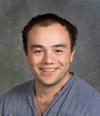
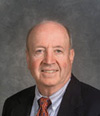 Maltz (L); Budinger.
Maltz (L); Budinger.
A paper by Berkeley Lab life scientists Jonathan Maltz (left) and Thomas Budinger has been selected for the Martin Black Prize for Best Paper Published in Physiological Measurement in 2005. Articles were selected for their presentation of outstanding new research, valuable reviews of the field, receipt of the highest praise from international referees, and the highest number of downloads from the journal website. Berkeley Lab’s entry is entitled “Evaluation of Arterial Endothelial Function using Transit Times of Artificially Induced Pulses.”